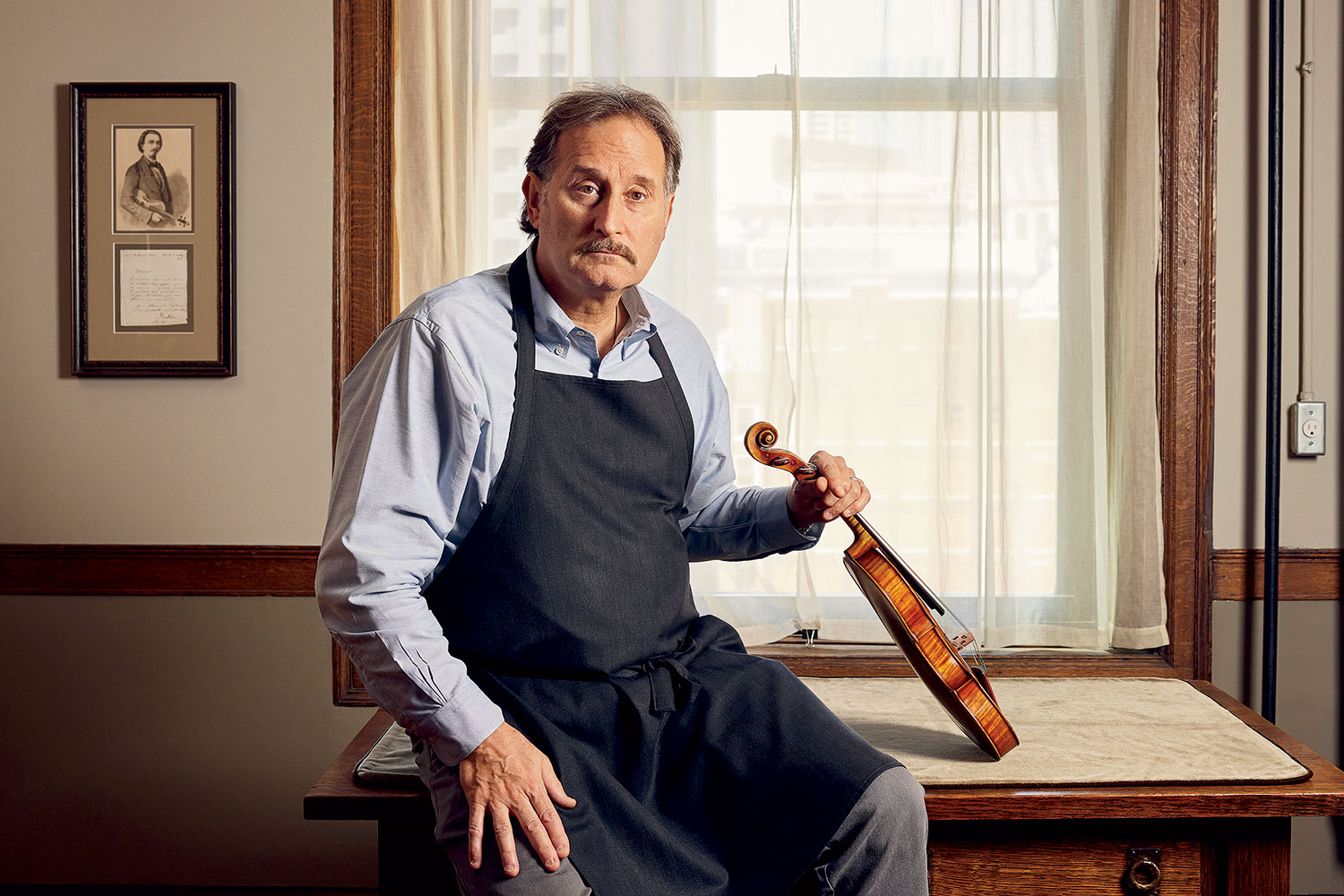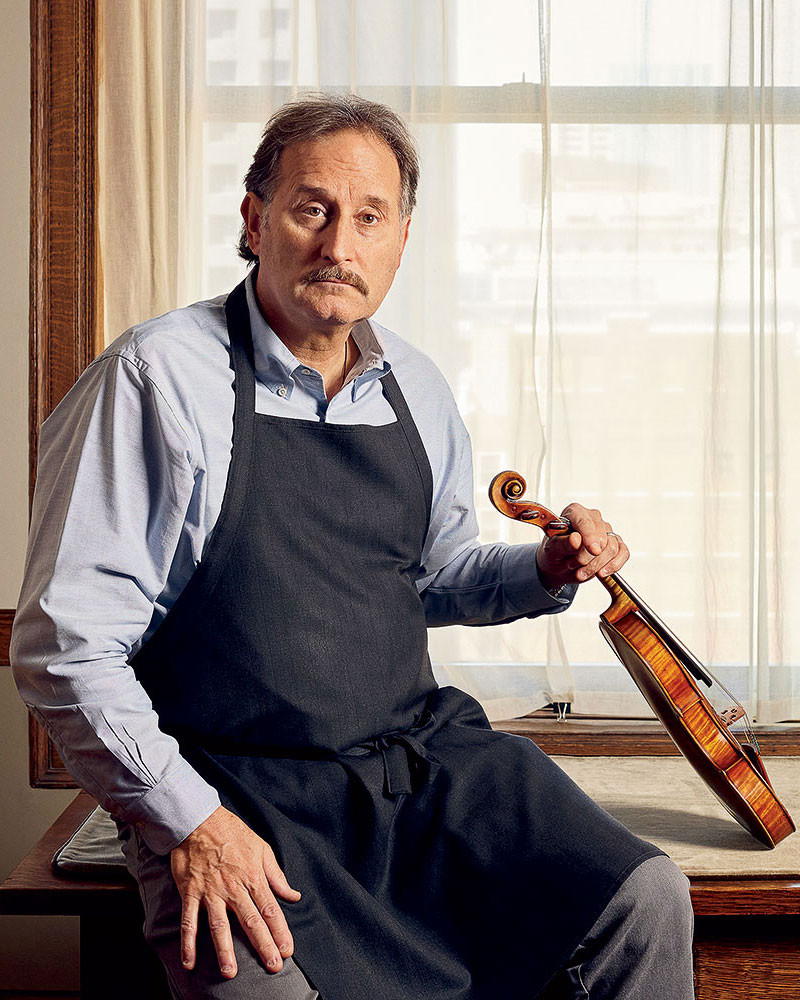It’s a few minutes past 10 in the morning, and John Becker stands just inside the door to his company’s office in the Fine Arts Building downtown. He wears a black workman’s apron, which he fits to his body by wrapping the ties around his torso twice. With his shoulders slightly hunched, he quietly observes the almost surreal scene unfolding before him.
A few feet away, Joshua Bell and James Ehnes, two of the most prominent solo violinists on the planet, hover over an Arts and Crafts–style wood table. Normally, Bell, a former child prodigy known for his virtuosic, animated playing, and Ehnes, a musician’s musician celebrated for his technical prowess, would be the superstars in the room. Both have won multiple Grammy Awards, and between the two of them, they have performed in nearly every major concert hall and with all the best orchestras in the world. But here, in Becker’s studio inside his office, another icon takes center stage.
“I’m really nervous and excited,” says Bell, his hands stuffed in his pockets. “It’s like meeting my wife again after two months. I’m a little overwhelmed.”
“Oh yeah, I understand the feeling,” Ehnes chimes in, his tone nearly giddy. His eyes are set on an object perched on a gray cloth that covers the tabletop. “I’ve never seen this violin before. It’s incredible. It’s so beautiful.” He pauses as though to take in every contour. The spruce wood — a swirl of orange and red hues — glows under the morning light. “It’s stunning.”
The violin in question belongs to Bell. The 310-year-old instrument, which Bell has said is worth as much as $15 million, is among the roughly 650 made by the renowned 18th-century Italian craftsman Antonio Stradivari that survive today. Bell left it with Becker for repairs, and over the past two months, the master luthier applied protective polish to preserve the original varnish, removed the top to make internal repairs, and handcrafted several cleats to reinforce tiny cracks in the wood. Bell has flown in from New York to retrieve the violin, which has been his concert instrument since 2001, before he departs on a tour of South America and Italy.
Ehnes plans to leave his own Strad with Becker for more minor repairs — a bridge adjustment, a varnish touchup, a new sound post — which will take only a day. The Canadian has made this essential stop before heading to concerts in South Korea and Japan.
Becker turns to Bell and asks if he wants to give the violin a try. It may look beautiful thanks to the fresh polish, but after 213 hours of painstaking work, the true test is how it feels and sounds.
“Yes, I do,” Bell responds, eagerly picking up the instrument.
Becker doesn’t play violin, but his ears are more attuned to the famed sound of Stradivarius instruments than perhaps anyone else’s in the world. He steps back as Bell raises his bow.
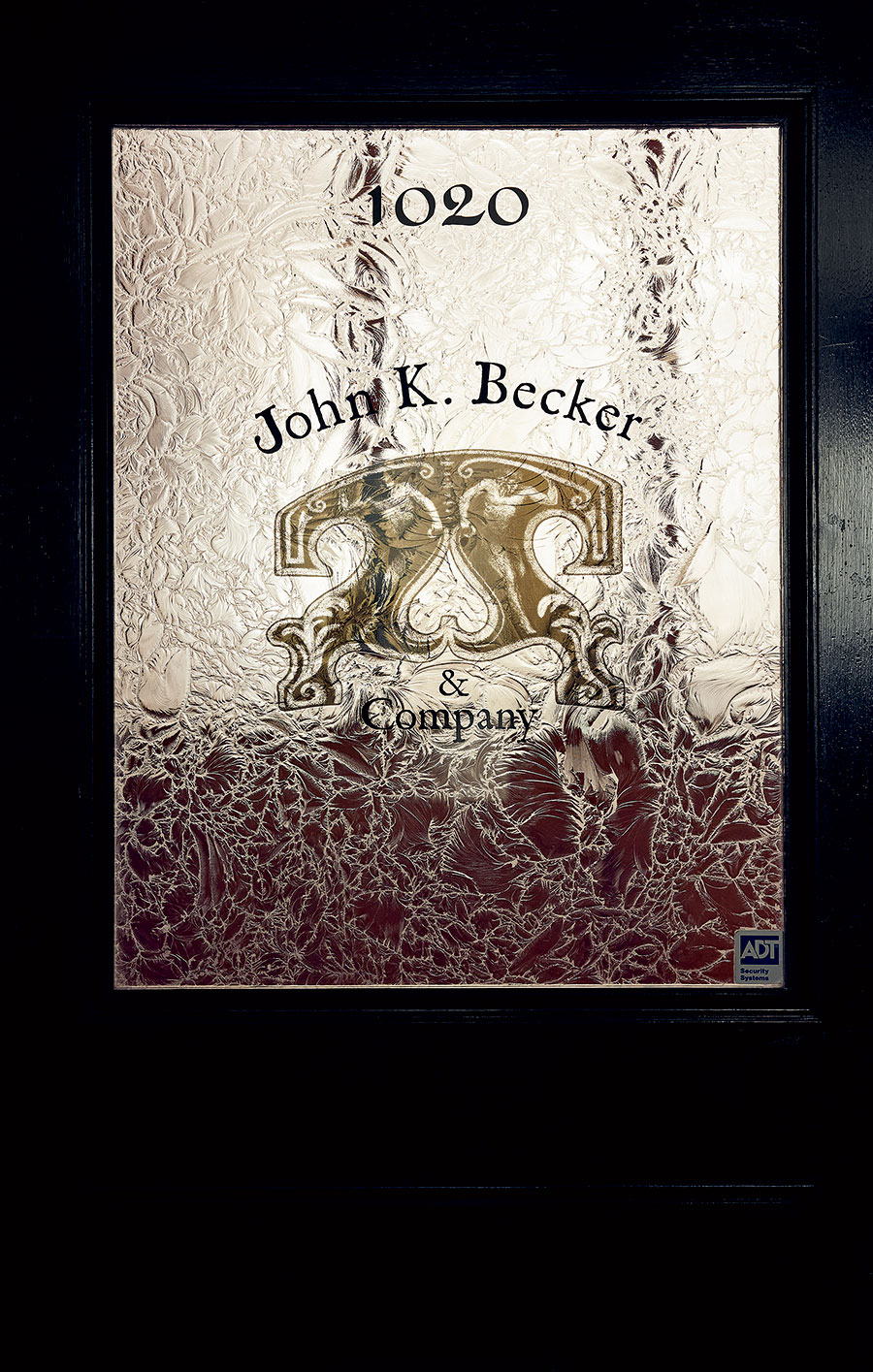
It’s impossible to exaggerate the mythic reputation of Stradivarius violins. Antonio Stradivari is considered one of the two greatest violin makers in history. (Giuseppe Guarneri del Gesù, his contemporary, is the other.) The surviving Strads, celebrated for their lyrical, robust sounds and delicate shape, are prized by collectors, musicians, and historians. Each boasts its own name — like the Messiah, the Ruby, Bell’s Gibson, or Ehnes’s Marsick — and all come with a long ledger of previous owners. One, the Molitor, is rumored to have been owned by Napoleon. Coveted in their time, Strads have only gained in esteem and value.
There are other luthiers with expertise in instruments from the Italian craftsman’s golden period, from 1700 to 1725, but master violin restorers are rare — around 20 worldwide now — and Becker is widely regarded as the best. At 64, he has worked on more than 120 Stradivarius violins — likely more, he says, than any other living person. David Fulton, a Seattle-based former software engineer and entrepreneur who once possessed the world’s largest collection of historic Cremonese instruments (named for the city where Stradivari and other renowned Italian luthiers worked) with 28, including eight Strads, entrusted Becker to care for them. (Fulton has since started selling off the bulk of them.) “He’s probably as fine a woodworker as lives on the planet today,” says Fulton. “Without men like him, these things would have decayed into splinters long ago.”
People travel from all over the globe to hand-deliver their instruments to Becker’s office, across the street from Grant Park. (When it comes to multimillion-dollar instruments, FedEx doesn’t cut it.) Once, says Becker, Nigel Kennedy, one of the most famous solo violinists of the 1980s, flew in from England for a day just so Becker could make him a new sound post, the small dowel that sits inside the violin and transfers vibrations from front to back. “He’s like a great surgeon,” says Bell. “His work is so meticulous. It’s like constructing a sailboat inside a bottle. There’s a reason I fly here to bring him my fiddle. He’s the master.”
When musicians visiting John K. Becker & Company arrive at the Fine Arts Building, at 410 South Michigan Avenue, they take a rickety elevator manned by one of the city’s last remaining operators to the 10th floor. The building, which features ornamented columns and arches and a Venetian-style courtyard, has been a hub for all kinds of artists since the early 20th century. One of the company’s workspaces sits in Frank Lloyd Wright’s former studio. Another was once rented by Wizard of Oz illustrator William Wallace Denslow. Becker & Company’s main entrance is at the end of the hall. The office’s vaulted ceilings are a relic of the building’s original purpose as showroom for carriages. On the door is an illustration by Becker’s wife, Anne, of a bridge modeled after that of the Medici tenor viola, likely the lone surviving one crafted by Stradivari.
Inside Becker’s studio, the sun streams through two skylights, bathing the space in a warm glow. It’s quiet. No music. No chatter. Just meditative scrapes and strokes of tools at work. Though the space is only about the size of a large bedroom, the high ceilings give it an airy feel. The temperature is kept at a cool 68 degrees all year, and humidity is tightly maintained between 50 and 60 percent. The room is divided into three workstations, occupied by Becker and the two Japanese luthiers he has employed since opening the shop 28 years ago. Becker’s faded bench, tucked into a corner, is scarred with scratches and a smattering of stains, remnants of projects past.
Most days Becker wears the same thing: slacks, a button-down shirt under his apron, and Finn Comfort shoes, a German brand that he prefers to any American counterpart. He keeps his nails short and his mustache long. Becker is soft-spoken and economical in conversation — he’ll never offer three words when one will do. He considers his words, often starting a thought with a lingering “OK.” He isn’t one for grand, theatrical statements. “Pretty cool” serves as high praise.
Becker’s daily rhythms verge on monastic. He arrives before 8 a.m. after a 90-minute Metra ride from his home in the northwest suburbs. He spends most of the day in his chair, hovering over a violin, and takes only two breaks: at noon for lunch and at 3 for a snack. At 4:45, he packs up and leaves to catch a 5:20 p.m. train home.
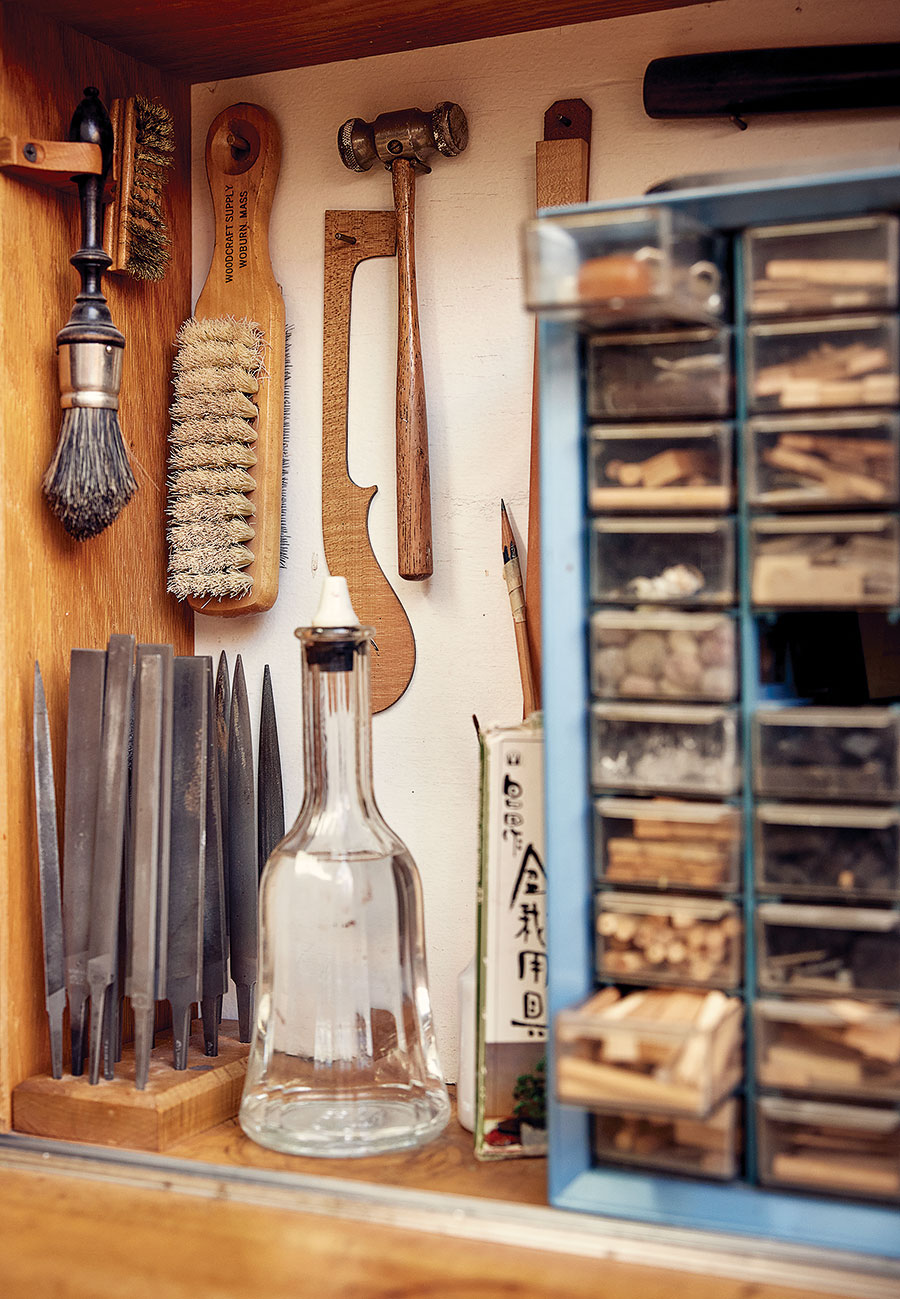
On this early August day, a week before the visit from Bell and Ehnes, Becker sits between his two luthiers, Takeshi Nogawa and Keisuke Hori. With his sleeves rolled up his forearm, Hori holds a thin cut of wood under a medical-grade microscope. It is, in fact, the top of an 18th-century violin made by the father of Guarneri del Gesù. (Three generations of the Guarneri family made violins.) The remaining pieces — the back, the ribs, the neck — rest a few inches away.
The instrument was brought in a few weeks earlier. The owner told Becker that it had been sitting in a garage for more than a decade after the owner’s father retired from professional music. The years of neglect warped the instrument and left it in desperate need of restoration.
Hori examines the disassembled violin closely. As he does, he holds a small brush in his left hand. When he spots a crack in the wood, he dusts it with water to dissolve any specks of glue that remain from previous repairs. Hori counts four large cracks around the bridge and sound post and a few smaller ones scattered across the top. Beneath each, along the violin’s underbelly, sits a tiny patch of wood, further evidence of previous repair. The patches are noticeably lighter than the original spruce, and their grain patterns are not nearly as fine. Hori intends to carefully remove and replace each. He has not yet selected the new material, but it will come from a large stock of tone wood that fills a loft space above the workshop floor. Becker has collected wood for decades, and most of his blocks are at least 40 years old. The longer the wood ages, says Becker, the better it gets.
He’s like a great surgeon,” says renowned violinist Joshua Bell. “His work is so meticulous. It’s like constructing a sailboat inside a bottle. There’s a reason I fly here to bring him my fiddle.”
After replacing each patch, one at a time over the course of several months, Hori will turn to the edges of the violin. He must replace the old top doubling, a rope-like half-inch-wide piece that marks the outer rim, delicately carving and placing it. Then he’ll address the back of the instrument. It, too, is sprinkled with cracks. The sides are in even worse shape. The curls of the thinly shaved maple are riddled with holes. The sight of them makes Hori both laugh and sigh. “A lot of damage,” he says.
“This is a very, very big job,” says Becker, looking up from his station. “It’s going to be about 1,000 hours of work.”
At $125 an hour, the company’s rate, that bill will total $125,000. Though the repair alone costs as much as some high-end violins, Becker estimates that once Hori’s work is finished, this Guarnerius could be worth as much as $800,000.
Becker used to handle the business side, but that job now belongs to his elder son, John Jr. Though John Jr. never studied woodworking, he grew up playing violin (he usually tests repaired instruments before his father returns them) and observing his father’s craft. “For my dad, I think there’s this idea of, if he’s not going to do this work, who is?” says the son. “There has to be someone protecting these special works of art, and they have to do it right. He really cares about preserving the instruments in the right way.”
For Becker, the work is an act of historic and cultural preservation. He often points to something Fulton once told him: “We are caretakers of these instruments. We move on, but these instruments continue to the next generation.”
Despite being perhaps the best of these caretakers, Becker has never actually played a Stradivarius. Growing up in Huntington Beach, California, he was more interested in materials than music. He liked to tinker with wood. He would carve sculptures and even made a skateboard in junior high. In high school, he began to explore woodworking more seriously. His first big project, a grandfather clock, won third place at the Orange County Fair.
His junior year, a friend was making a guitar, and Becker decided to give it a try. “It looked really fascinating to me,” he says. “The bending of the sides and how delicate and thin it was — it looked very challenging. And it looked like something I would really like to do.”
But Becker didn’t want to make just any guitar — he wanted to customize one for a musician he admired. So a year later, after his family moved to Chicago, Becker sought out Randy Wolfe (better known as Randy California), the original lead singer and guitarist of his favorite band, Spirit, following a concert. “I asked him what he liked,” Becker recalls, “and he said he liked a Fender scale, which is a longer neck than a Gibson, and the whammy bar.”
Becker got to work. When he eventually finished the guitar, five years later, he put it in a case and presented it to Wolfe before a Spirit concert at Beginnings, a now-shuttered venue in Arlington Heights. “His eyes — he was just mesmerized,” Becker recalls.
Later that night, when the audience called Wolfe back out for an encore, he returned with Becker’s guitar in hand and christened it with a rendition of “Wild Thing.” “It was crazy,” Becker says. “Making that guitar had a big impact on me. I didn’t grow up in a musical family, but I realized I wanted to help musicians. I get that same excitement working with classical violinists.”
Becker often points to something a collector once told him: “We are caretakers of these instruments. We move on, but these instruments continue to the next generation.”
After graduating from high school, Becker joined the apprentice program at Lyon & Healy, the internationally renowned harp manufacturer in the West Loop. There he learned how to make the instrument part by part — first the process of crafting the base and gluing the columns, then the technique of carving and shaping the curves that define a harp’s structure. When Lyon & Healy commissioned a special harp for the company’s 100th anniversary just a few months into his apprenticeship, the company asked Becker to build it. “It had this intricate geometric shape,” he recalls. “The carvings wrapped around a cylinder, and it all had to match up. It was tough, but it turned out really well, and it remained in their showroom for years.”
After a little more than a year at Lyon & Healy, Becker wanted to try his hand at something else. He was drawn to the idea of working on rare violins — “I could see it was a craft” — and applied for a position at the prestigious violin dealer and restoration shop Bein & Fushi in 1979. Also located in the Fine Arts Building, Bein & Fushi ran a cutthroat apprentice program, but Becker’s talent was obvious from the start. “They said I was the best person they’d ever had,” he says.
When the top restorer left in 1982, Becker was tapped to fill his shoes. His first repair? The Adam, a 1714 Stradivarius violin named for a former collector. The business’s co-owner Robert Bein had given his employee The Secrets of Stradivari, a book by the acclaimed Italian luthier Simone Sacconi outlining the author’s best practices, and Becker absorbed them all. “I did some great work on that instrument,” he says.
In 1989, Becker took over as head of the entire workshop. Already renowned, Bein & Fushi became one of the world’s most prominent violin shops during Becker’s time there, thanks in large part to his work. “He was brilliant,” recalls Drew Lecher, who worked alongside him. “I guess you could say he had a Midas finger. If a violin didn’t sound right, he’d make it sound right. And if it didn’t look quite right, he’d make it look right. He was the standard-bearer.”
In 1994, after 15 years with Bein & Fushi, Becker left to open his own shop just a few doors down the hall. And it’s there, under the glow of those skylights, that Becker has quietly assembled his reputation as a preeminent luthier.
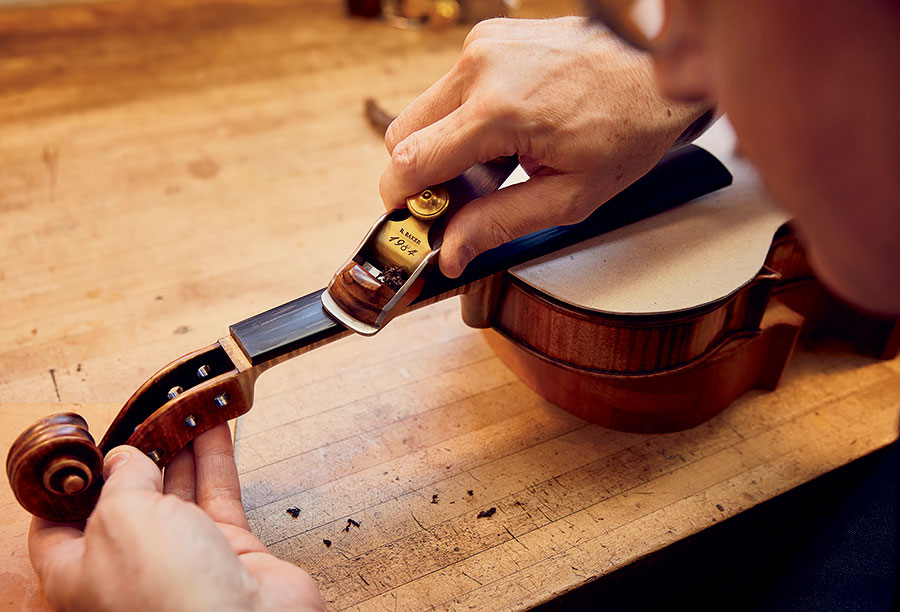
Becker & Company commissions are generally split into two kinds of projects: repairs and restorations. Repairs involve smaller improvements, such as carving a new bridge to improve the instrument’s tone. Or fashioning a new fingerboard — the long piece of ebony wood that runs along the neck. Or touching up the varnish. These types of repairs take anywhere from a day to several weeks.
Restoration, by contrast, can take several months or even years. While some restorations involve only a specific area in need, others require taking the entire instrument apart and redoing every previous repair. Becker has completed several such jobs for David Fulton, the collector. The first one was the Baron Knoop, a 1715 Stradivarius. Becker carefully removed the old retouching and French polish to reveal the original Stradivari varnish, which had been hidden. The violin also had several deteriorating patches of wood, which Becker replaced. He made a new sound post, bridge, and base bar, built a new fingerboard, adjusted the pegs, and reset the neck. In all, the job took three months. “John restored the violin to what it ought to be,” Fulton says.
One early September morning, Becker sits at his desk holding a 1694 Stradivarius in one hand and a small metal straightedge gauge in the other. With his glasses perched on his nose, he brings the instrument under a bright lamp and places the tool in three different spots along the violin’s fingerboard. How the fingerboard sits beneath the gauge indicates where it has changed shape under the weight of the owner’s fingers. This board, Becker says, has been significantly worn down, as evidenced by several small ridges that give it almost a wave-like texture.
Asked to explain his precise methods, Becker points to instinct. “These instruments have a certain soul,” he says. “People think it’s magic, but it’s just experience.”
It takes Becker only a few seconds to make the assessment, and then he gets to work, sliding a trimming plane back and forth across the fingerboard in a motion that mirrors an iron gliding across a wrinkled shirt. Small ebony shavings begin to gather around the instrument. Becker occasionally pauses to remeasure the board. He’ll continue trimming until he’s satisfied with the shape, which must be just right to ensure the strings don’t buzz.
Becker also plans to replace the violin’s sound post, which he had noticed was slightly loose. Carved from aged spruce, it’s an unassuming yet critical piece. When its tension isn’t precisely right, the instrument will not resonate properly. A well-fitted sound post is essential to revealing the full richness of the violin’s timbre.
The new sound post will be a tenth of a millimeter taller than the current one. The additional length will help the post sit more snugly and create the appropriate tension. Becker will begin with a piece of spruce and plane it into a cylinder. From there, he’ll take off tiny shavings with a small knife until the piece reads 52.8 millimeters tall and 6.4 millimeters wide. He has made hundreds of sound posts over his career. That part isn’t particularly difficult. The art rests in maneuvering the sound post through one of the violin’s two f-holes and placing it in exactly the right spot. But Becker is pretty good at that, too. “You know what game I played all the time?” he asks rhetorically. “Operation. I was really good at Operation.”
These days, many of Becker’s surgical tools fill two cubbies above his desk. On one shelf sit bottles of glue made from horse parts. Becker, like most high-end luthiers, prefers hide glue because it is water soluble, which makes reworking previous repairs easier, and elastic, which allows it to expand and contract with the wood over time. Another shelf is lined with an array of devices Becker has collected. Some, like his 19th-century carving tools, he found in antiques markets. Others, like the fine art files, came from France. Still others were custom-made for his needs.
Among the tools is a thin, curved piece of metal that resembles something a dental hygienist might use to scrape plaque. This is what Becker uses to place the sound post. He’ll do so in one swift, balletic movement, with only small adjustments thereafter. No hesitation. No backtracking. He seeks a moderate tension, neither tight nor loose, and his confident gesture reflects decades of practice. Becker’s precision at this even garnered him a nickname from violinist Nigel Kennedy: the Postmaster.
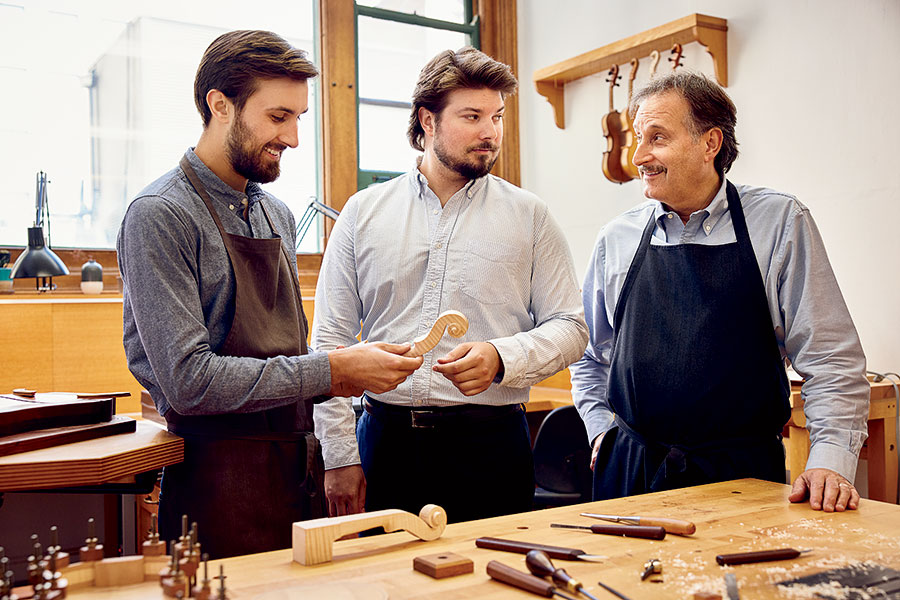
The secret of the Stradivarius sound — powerful, lyrical, and assertive — has been a subject of obsession for musicians, scholars, and alchemists for centuries. One hypothesis posits that Stradivarius used Alpine spruce that grew during an uncommonly cold period, which made the wood unusually dense. Another theory focuses on the varnish, suggesting that the Italian craftsman used an unusual set of ingredients to achieve his signature honey color. A paper recently published in the German science journal Angewandte Chemie concludes that soaking wood in limewater, among other chemicals, created the unparalleled timbre. Scientists have used 3D lasers and CT scans to measure the precise geometry of a Stradivarius, but so far no one has been able to replicate its sound.
That doesn’t stop contemporary violin makers from trying — Becker’s younger son, Garrett, among them. He builds four instruments a year, each modeled from measurements he takes of the Strads brought to his father, and sells them for $27,000 apiece.
Becker’s ability to pull the best sound out of Strads carries its own mystery, too. Asked to explain his precise methods, he points to instinct: “These instruments have a certain soul. When a soloist brings their instrument in, I don’t need them to tell me what’s going on. I watch them, I watch their bow, I watch their fingers. People think it’s magic, but it’s just experience.”
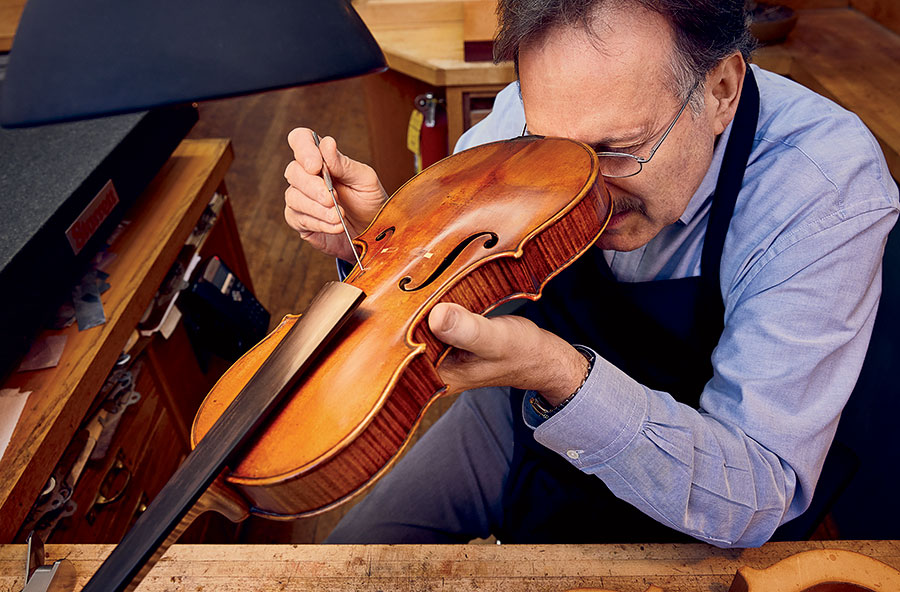
James Ehnes has been bringing his Stradivarius to Becker for more than 20 years. As a celebrated solo violinist, he’s had the opportunity to play more than 100 Strads, many loaned to him by collectors for concerts or competitions. But when Ehnes first saw the Marsick in 1996, he knew it was special. Named for its 1916 owner, the Belgian violinist Martin Pierre Joseph Marsick, the instrument disappeared for nearly a century after landing in Russia just before the 1917 revolution. “The Marsick was the one I couldn’t shake,” says Ehnes. “The character spoke to me. I had this feeling that it was going to be really exceptional.”
In 1999, David Fulton, a friend of Ehnes’s, bought the violin for him to play. Ten years later, Ehnes purchased the instrument from him. Over those two decades, Ehnes has worked with Becker to bring the instrument back to life. “I knew what I wanted out of it,” Ehnes says, “and John knew how to find it.”
Ehnes brings the violin to Chicago for maintenance at least once a year. Over time, he and Becker have become close, building a friendship through mutual admiration and a shared reverence for Stradivari’s craft. “John just really respects the instruments,” says Ehnes. “He’s not trying to put his mark on it. He’s trying to let each individual instruments live up to its own potential.”
Their long partnership is one reason Becker wanted Ehnes to inaugurate the first bowed instrument the luthier has built from scratch. Becker started working on the instrument, a bench copy of a Carlo Tenoni viola, while restoring the original at Bein & Fushi in the 1980s. But he never finished it, as family and professional duties got in the way. Then the pandemic hit. With a near-total stop in work, Becker suddenly had a lot of free time, so he decided to pick the project back up. He completed it just a few days before Ehnes arrived to drop off the Marsick.
Back in Becker’s office that mid-August day, an hour before Joshua Bell is due to pick up his violin, Ehnes takes the deep cherry viola from Becker.
“I can’t tell you how excited I am,” says Ehnes, eyeing the instrument with delight. “This is a moment.”
“It plays a little like a Ferrari,” says Becker. “Give it a spin. See what you think. It was a long time in the process.”
Ehnes begins to tune the four strings. Once satisfied, he pulls his bow across them and starts to play. After just a few seconds, he stops and looks at Becker, visibly astonished.
“The beauty of the core of that sound, you know how rare that is,” he says. “You just don’t find it. You nailed it. You absolutely nailed it.”
Becker’s mouth curls into a smile and he laughs sheepishly. “Sometimes it works out.”
Ehnes turns back to the viola and starts playing again. He runs through excerpts from various Brahms violin sonatas, then Schumann’s Märchenerzählungen (Fairy Tale Narrations). The low notes sound big and bold, while the delicate top ones dance and glitter. He then moves to Berlioz’s Harold in Italy and Bach’s Partita no. 1, filling the office with a palpable sense of melancholy.
Ehnes pauses again. “It’s sort of Strad-like in its concentrated sound. That amazing density. It just doesn’t feel new at all.”
“I know,” Becker answers. “It’s really weird.”
If anyone were to create an instrument that replicates the ghosts of Cremona, it would be Becker, a man who has spent his career conjuring the sounds of 18th-century Italy.
When Ehnes returns the viola, he asks Becker what he intends to do with it. Becker shrugs. He’s not sure if he’ll sell it or keep it for himself. But wherever it goes, the viola will someday require repairs. And if it lands in hands as skillful as Becker’s, maybe it too will eventually become an antique that carries the music of centuries past.



